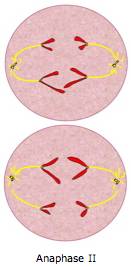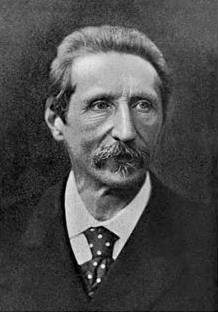Anaphase II
Stages of Meiosis
A video about anaphase II (as well as the other stages of meiosis II)|
|
EUGENE M. MCCARTHY, PHD
| < | Mitosis | Meiosis | > |

|
Related Topics: |
Anaphase II
Note: Meiosis II is very similar to mitosis. The primary difference is that in meiosis II only one member of each homolog pair is present, whereas in mitosis both are.
During anaphase II, the third step of meiosis II, the sister chromatids of each chromosome separate and move toward opposite poles. Once they are no longer connected, the former chromatids are called unreplicated chromosomes. As the chromosomes are dragged along by the spindle apparatus, their arms can be seen dragging along behind so that the chromosomes form V-shapes. The poles themselves move further apart as cytokinesis begins and the cell lengthens (not shown in figure).
| Note: Ana is a Greek word meaning, among other things, back, which to Adolf Strasburger, the namer of this phase, referred to the chromosomes moving back into compacted nuclei (more about Strasburger below). |
| Mneumonic device: You can remember the first letters of each of the stages of meiosis in order by remembering one of the following three sentences: "Peter made a tart." OR "Passed my anatomy test!" OR "Perhaps my Aunt Tillie." Take your pick. |
|
A silly poem to help you remember: Mitosis happens everywhere, even in my toe, Meiosis only happens in my OH! |
| Note: The term chromatid is used only to refer to one of the two united halves of a replicated chromosome. Once the sister chromatids move apart, each is called a daughter chromosome or unreplicated chromosome. |
Eduard Adolf Strasburger (1844-1912)
The terms prophase, metaphase, and anaphase were coined by the Polish-German botanist Eduard Strasburger (Strasburger 1884, pp. 250 and 260), who together with Walther Flemming (1843-1905) and Edouard van Beneden (1846-1910) was the first to describe the process of chromosome distribution during cell division (telophase was only later given a distinct name). In Strasburger's description, metaphase continued until the daughter chromosomes were entirely separate from each other, whereas today it is usually regarded as ending as soon as the kinetochores begin to move towards the poles. Ana is a Greek word meaning, among other things, back, which to Strasburger referred to the chromosomes moving back into compacted nuclei. Strasburger also originated the terms cytoplasm and nucleoplasm, and was the first to accurately describe the embryo sac and to demonstrate double fertilization in angiosperms. He also originated the well-known rule that new cell nuclei can only arise from the division of preexisting ones. Cited reference: Strasburger, E. 1884. Die Controversen der indirecten Kerntheilung. Archiv f端r mikroskopische Anatomie 23:246-304. |
Most shared on Macroevolution.net:
Human Origins: Are we hybrids?
On the Origins of New Forms of Life
Mammalian Hybrids
Cat-rabbit Hybrids: Fact or fiction?
Famous Biologists
Dog-cow Hybrids
Prothero: A Rebuttal
Branches of Biology
Dog-fox Hybrids
